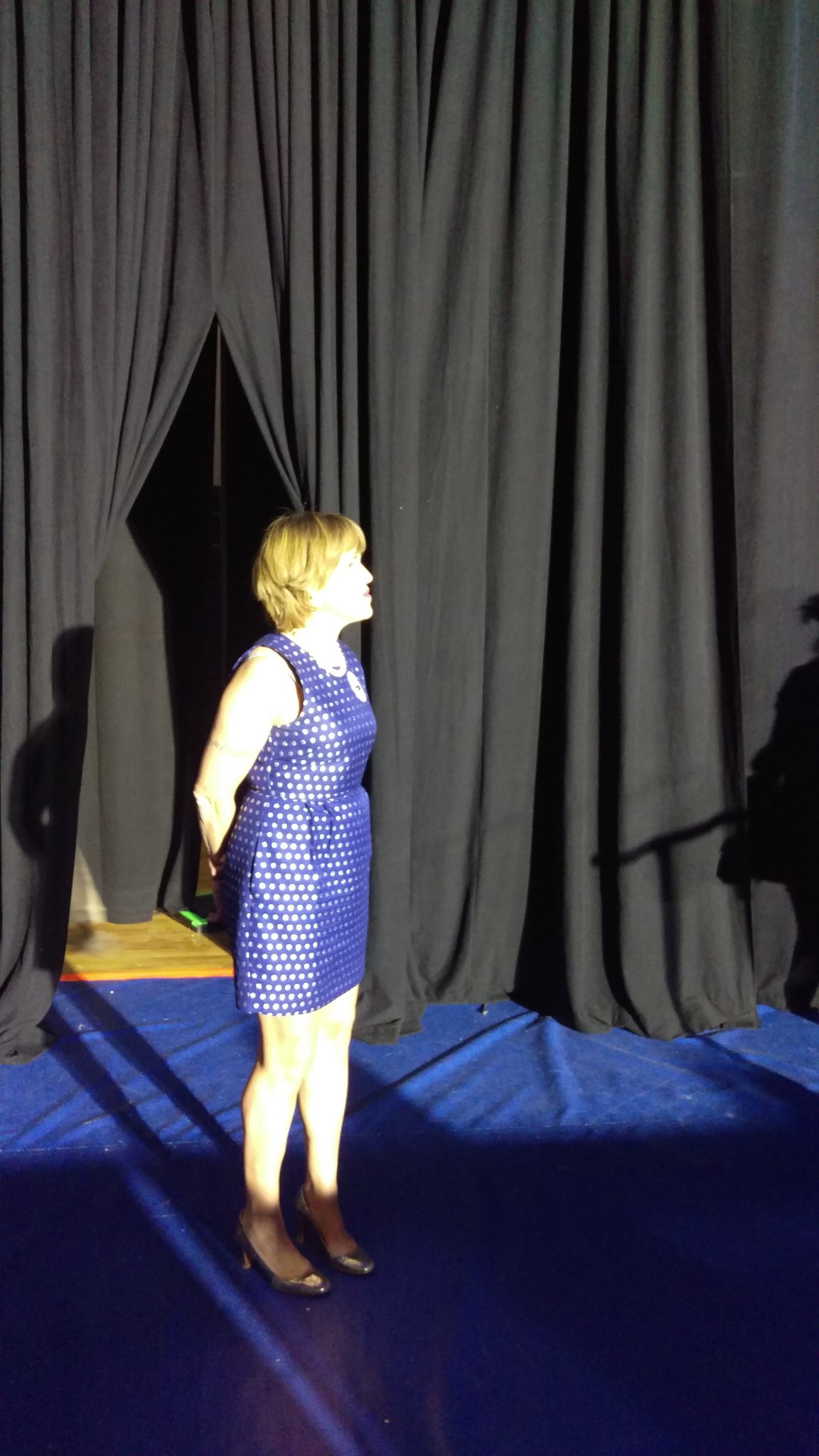After skipping the Nevada caucuses due to teaching obligations (and limited funding) we are back on the campaign trail, spending the last three days in sunny and warm(er) South Carolina leading up to today’s crucial primary vote in the Palmetto state. Our impression, after attending rallies, and talking to locals, is that this is Joe Biden’s race to lose, but it is an impression based more on what we are not seeing at other candidate rallies rather than overt signs of support for Joe – in fact, we have yet to make a Biden event, although are scheduled to attend what we assume will be his victory party tonight on the South Carolina campus in Columbia.
At this early stage in the race for the Democratic nomination, each contest is viewed as more crucial than the previous one. But even by these standards, South Carolina is particularly significant. In 2016, African-Americans made up more than 60% of the Democratic electorate in the Democratic primary here, and it proved the beginning of the end of Bernie Sanders’ candidacy, as the results were the first confirmation that he could not win the black vote; according to exit polls, Sanders received only 14% of the black vote, a pattern that would repeat itself throughout the 2016 campaign. Unless he can dramatically improve that total today, his candidacy is likely to struggle again, although much depends on whether any other candidate can consolidate the black vote.
Joe Biden, meanwhile, has staked his presidential campaign on winning South Carolina, and doing so decisively by drawing on black voters. Not surprisingly, his ads down here are narrated by Barack Obama, and they overwhelmingly show him on screen with the former President. I have been arguing since Biden’s 4th place finish in Iowa, followed by a disappointing 5th place result in New Hampshire, that pundits are wrong to write his candidacy off, and that we really wouldn’t know until South Carolina just how strong his candidacy is. At the same time, count me as skeptical that Bernie Sanders, despite his front-runner status, has demonstrated that he can win the Democratic nomination by doing well in states with a substantial population of racial minorities. So South Carolina is a crucial test for both candidates – one whose importance transcends the 54 delegates at stake (35 allocated across 7 congressional districts, 12 allocated statewide, and 7 superdelegates).
We started our latest campaign trip by flying from Boston into Charlotte, North Carolina on Thursday night, and driving down for an afternoon lunch on Friday at the Palmetto Pig in Columbia, South Carolina’s capitol, with Tom Steyer. Steyer has been flooding the airwaves down here with ads, and the RCP poll has him locked in a battle for third place with South Bend Mayor Pete Buttigieg. Both are trailing Biden, who looks to be consolidating support, and Sanders, who polls suggest – as in the previous contests – is matching his 2016 performance, but not showing much evidence of expanding it.

The Palmetto Pig also gave us our first opportunity since 2016 to sample South Carolina barbecue, which we have been assured by locals is far superior to anything Texas has to offer. While Tom worked the small luncheon crowd, we chowed down on fried chicken – saving the barbecue for later – and listened to the locals discuss his candidacy.
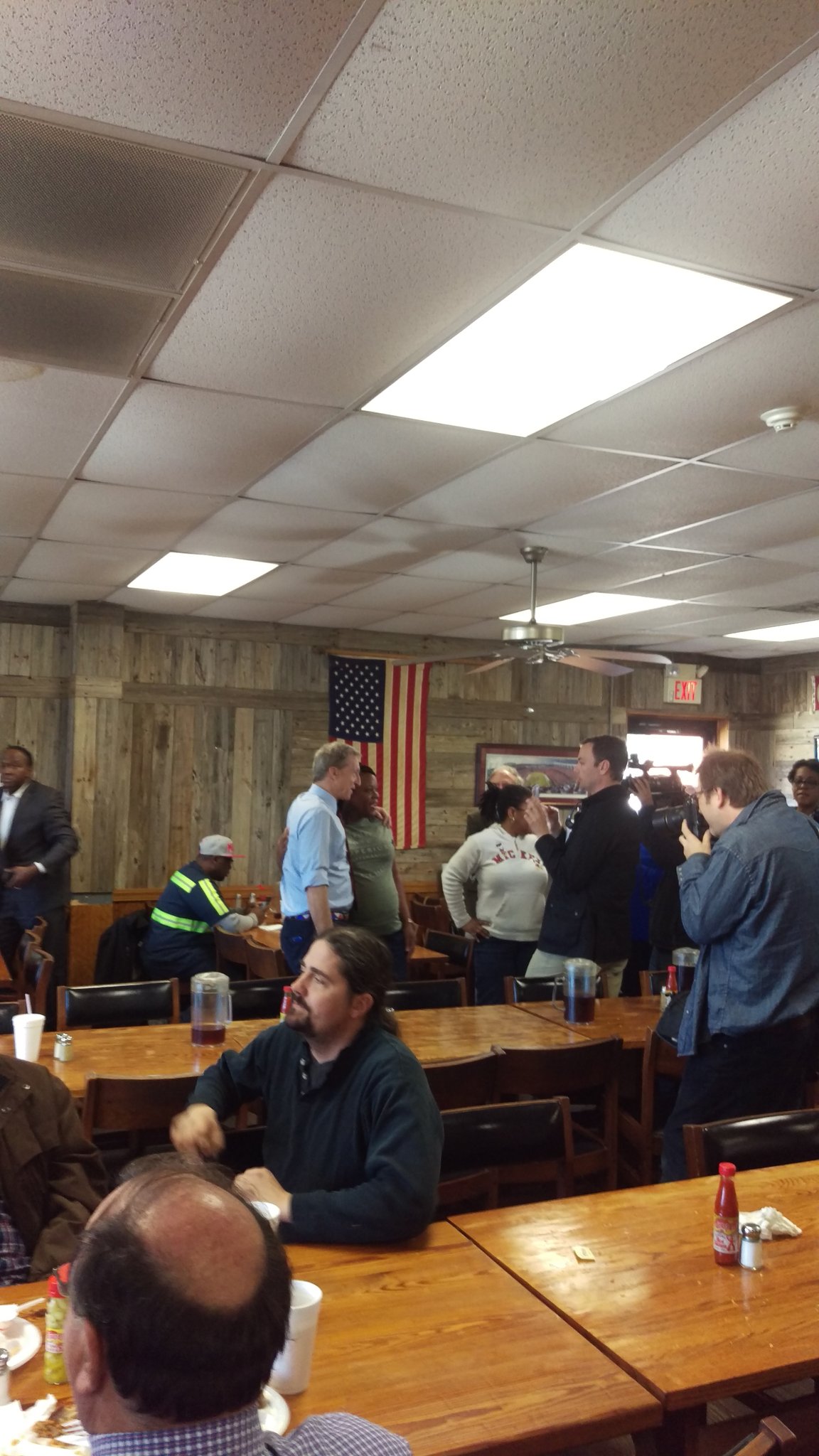
Eventually Tom worked his way to our table, and we noted that we had seen him in New Hampshire art one of his events. When I jogged his memory by reminding him that we were neighbors with a local climate activist – Steyer’s signature issue is battling climate change – and that our kids attended school together, he immediately referenced the activist’s child’s name. “You thought I was kidding about knowing them, didn’t you?” he said.
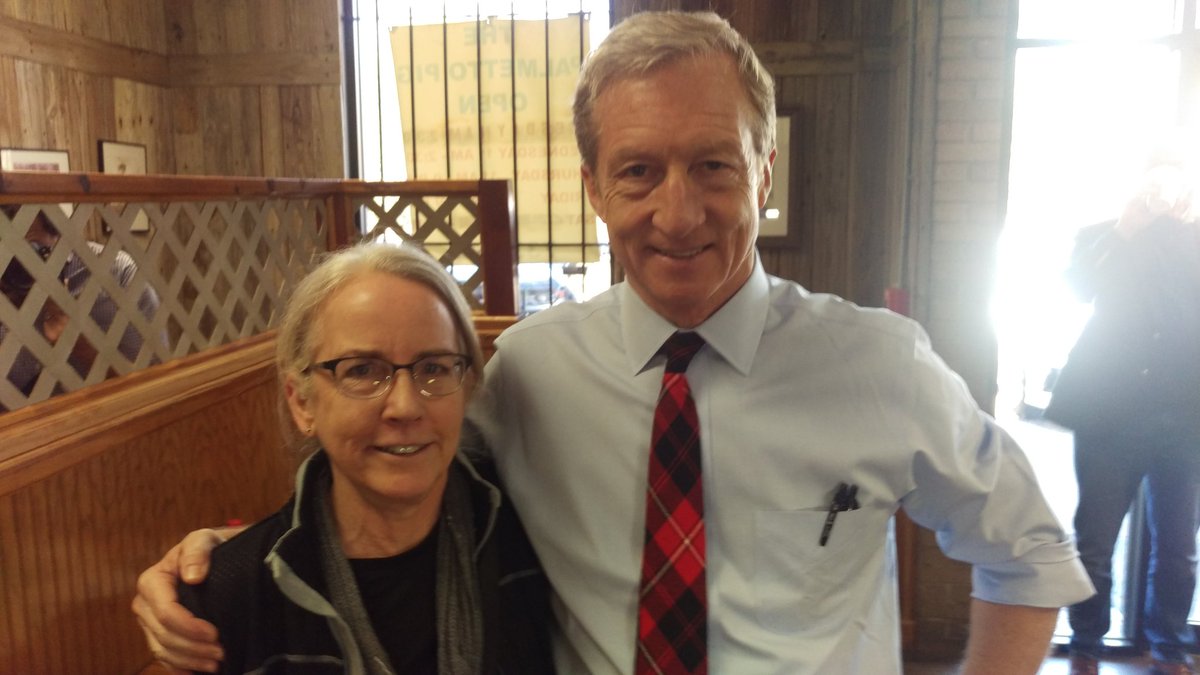
Steyer is a very personable guy, who comes across as incredibly sincere in his desire to combat climate change, and is earnestly working to develop a movement to achieve that goal. At the same time, however, there’s a sense that he is coming to these issues from a position of wealth, and that he’s not always sure of the practical political steps that are necessary to draw support to his cause. The Well Known Vermont Politician and I find Steyer a lot like a rich kid who wants to be part of the regular crowd, but isn’t quite sure how to fit in. I’ll develop this point in a second post when I report on his visit to a historically black college in Columbia.
Meanwhile, after finishing up with Steyer, we headed over to Finlay Park where Sanders was holding an outdoor rally.
It was the first candidate rally that required us to pass a security check to enter the enclosure. Immediately after clearing the gate, an organizer came over to ask us to sit on the stage behind Bernie. Having attended multiple Bernie events, we realized this would require us to fake sincere enthusiasm, stand frequently, wave signs like a maniac, and generally act like Bernie was the Second Coming (which he is, according to multiple Bernie Bros who have attacked me discussed his candidacy with me on social media.) We declined the offer, and instead watched the event next to the media stand. As we waited for Bernie to arrive, we were treated to music by the hip-hop duo from Texas (as they repeatedly told us) named Blackillac who revved up the crowd with a high-energy performance. As soon as they left the stage, the sound system played Simon and Garfunkel’s American. I couldn’t think of a better juxtaposition of music to demonstrate who actually supports Bernie.
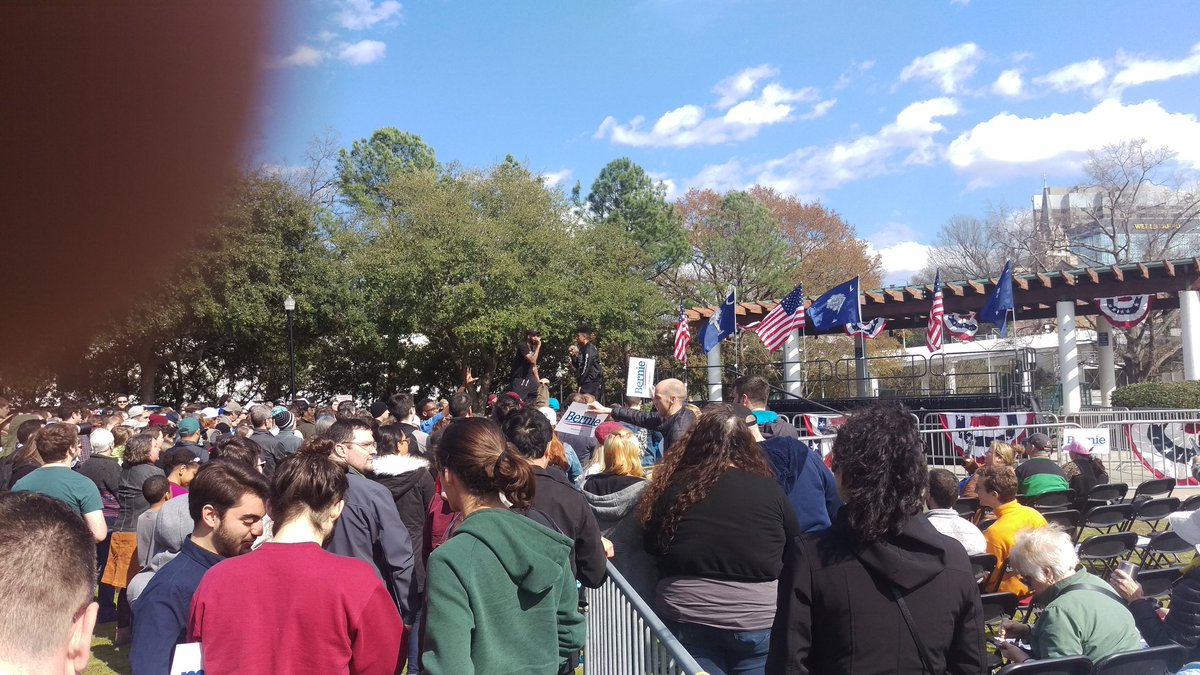
After the requisite warm up speakers, highlight by a frail-looking Danny Glover, a wickedly funny Killer Mike, and the always energetic Nina Turner, Bernie came on to deliver the standard Bernie riff. As always, Bernie is “sick and tired” of a number of things, including: “billionaires trying to buy elections” and the outsized influence of the 1 percent more generally; student debt; ½ of people living “paycheck to paycheck”; and homelessness. Except for a couple of deviations that I discuss below, his speech was the standard one that I’ve reported in previous posts, so I won’t elaborate in much detail here.
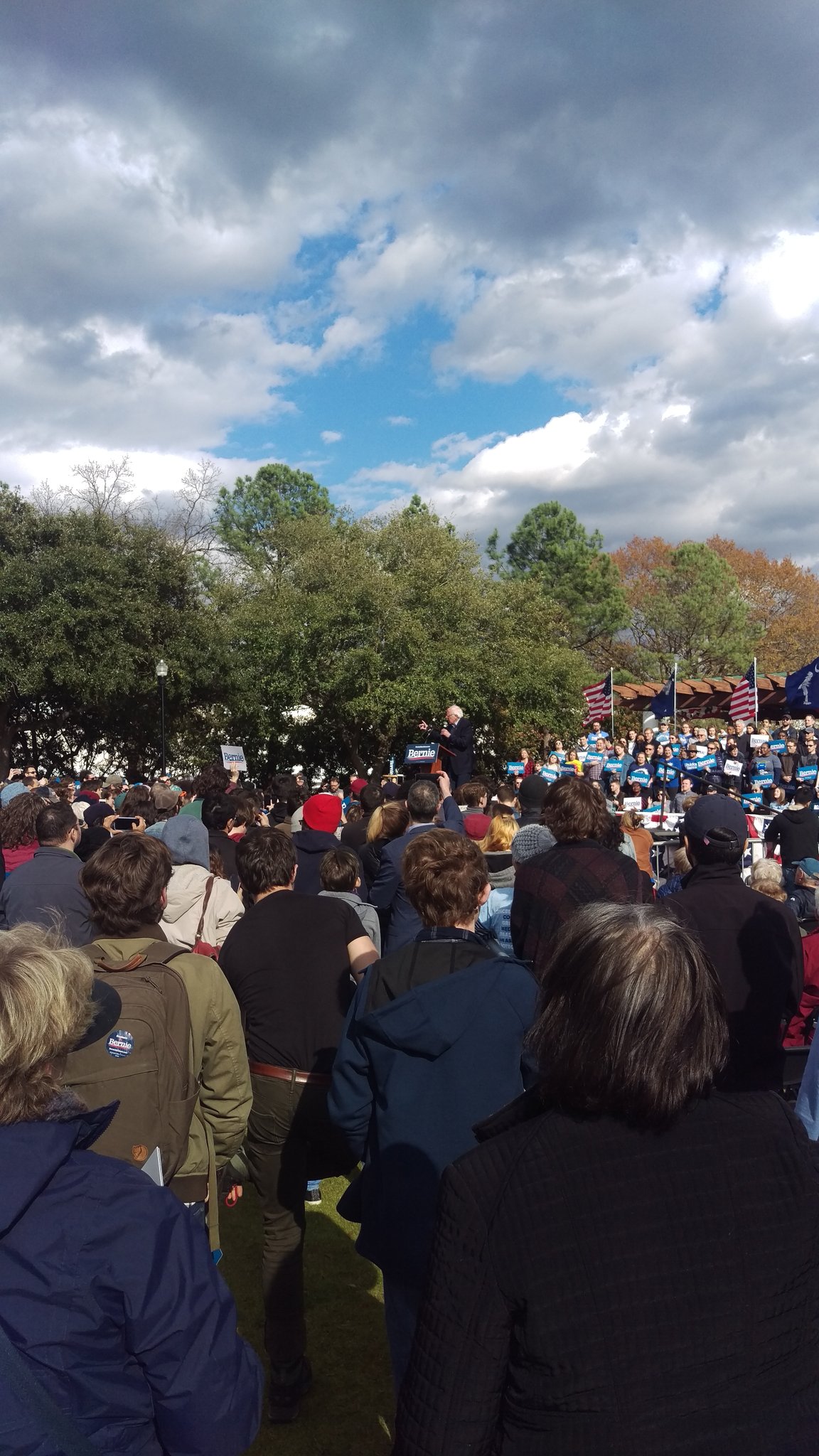
For a 78-year old man who suffered a heart attack not long ago, he remains remarkably energetic. His speech deviated from his NH version in a couple of significant ways. First, it began with an extended attack on Donald Trump’s decision to hold a counterrally in Charleston South Carolina which was designed, according to Sanders, to “meddle in the Democratic primary.” It is a reminder that South Carolina holds an open primary, which allows independents to vote in either the Democratic or Republican contest, and that Sanders does well among those independents who have soured on the party establishment. It appeared he was hoping to draw them into the Democratic race on his behalf. At the same time, he pushed back against pundits’ claims that he couldn’t win the general election; here Sanders cited the multiple polls showing him defeating Trump in a one-to-one matchup.
The second deviation was a much more explicit outreach to racial minorities than what we heard in New Hampshire. He began by describing the multiracial nature of his support, and how his candidacy depended on boosting turnout to record levels in South Carolina, particularly among blacks and Latinos. After touting his proposals to expand health care (“ending the international embarrassment that the United States is the only industrialized nation that doesn’t guarantee universal health care as a human right”); eliminate student debt; raise the minimum wage; and push a Green New Deal, Sanders touted his positions on criminal justice reform. He promised to end cash bail, eliminate private prisons, end the war on drugs and instead legalize marijuana, and expunge the records of those convicted of marijuana possession. He also discussed restarting DACA (Deferred Action for Childhood Arrivals) and pursuing immigration reform.
Sanders concluded by reminding listeners that this was “the most consequential election” of this generation, and that they shouldn’t underestimate the power of the 1% – Wall St., the military-industrial complex, and Big Pharma – to thwart the wishes of the majority. He urged audience members to canvass on his behalf. “If we stand together and keep our eye on the prize, all the money in the world won’t stop us.”
All told Bernie spoke for about ½ hours to a very receptive, mixed race audience of just under 800 people. It leaned toward the young side, although there was certainly a spectrum of ages in attendance. Given the outdoor location, however, we were somewhat surprised that the crowd wasn’t bigger. Moreover, although they were clearly receptive to Bernie’s message, the event lacked the high-pitched energy that one might expect from a candidate poised to pull an upset. This was a gathering of the faithful come to pay homage to their standard bearer, and from that perspective it was a success. But I didn’t come away from the rally convinced Bernie was pulling in new voters from beyond the coalition that had supported him in 2016. We’ll know soon enough, however whether that impression is wrong.
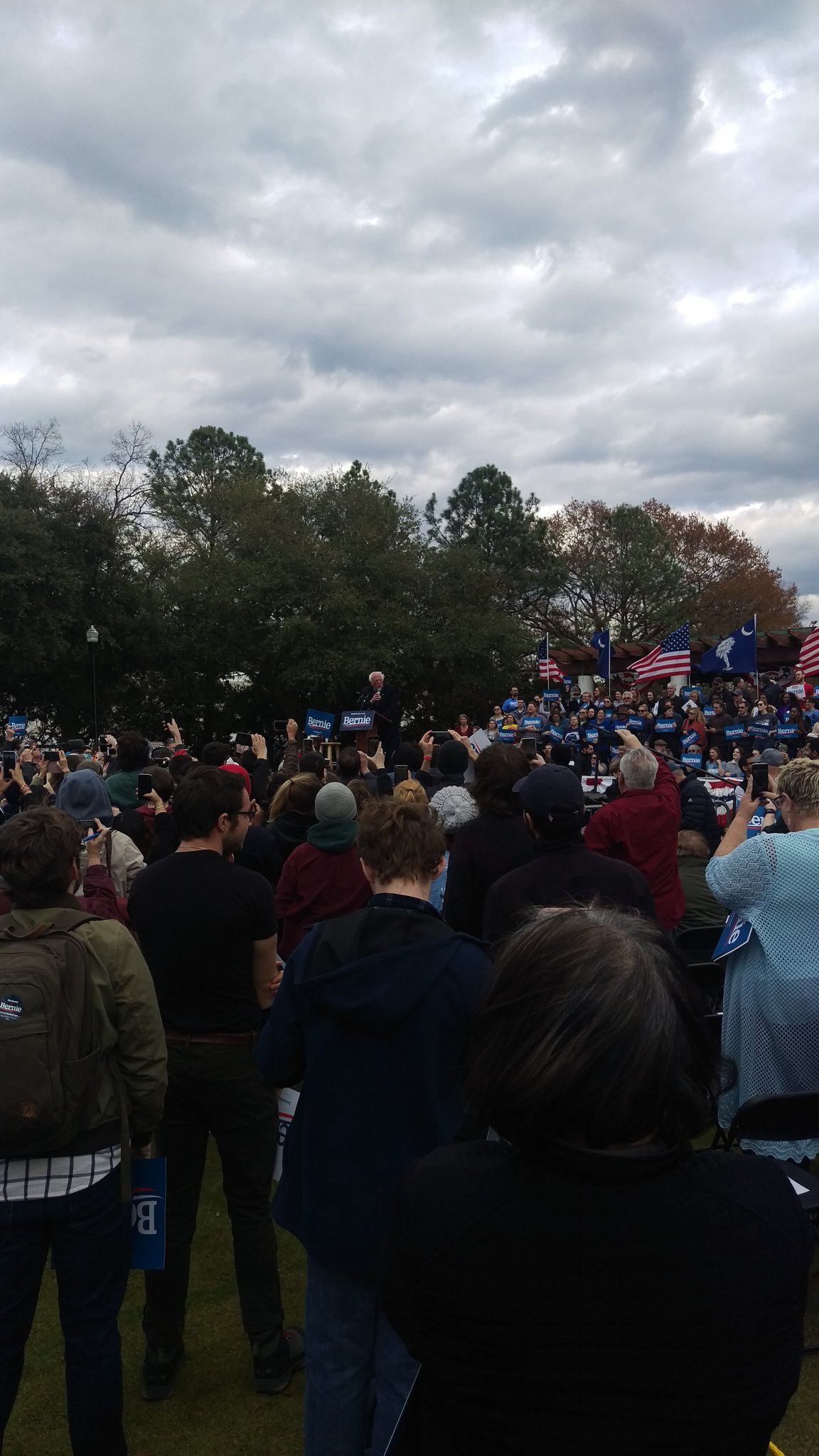
After finishing up with Bernie, we headed out to a Tom Steyer rally at Allen University, a historically black college, where one of the more unusual scenes in the Democratic race so far took place. That will be the subject of my next post. To whet your appetite, I leave you with a picture of a spellbound Kat Taylor watching her husband on stage. Soon she would join him back on stage, along with rapper Juvenile, to make some awkward history.
